 "ttyymmnn" (ttyymmnn)
"ttyymmnn" (ttyymmnn)
12/03/2019 at 12:35 • Filed to: wingspan, Planelopnik, TDIAH
 5
5
 12
12
 "ttyymmnn" (ttyymmnn)
"ttyymmnn" (ttyymmnn)
12/03/2019 at 12:35 • Filed to: wingspan, Planelopnik, TDIAH |  5 5
|  12 12 |
!!! UNKNOWN CONTENT TYPE !!!
Welcome to
This Date in Aviation History
, getting of you caught up on milestones, important historical events and people in aviation from November 30 through December 3.
!!! UNKNOWN CONTENT TYPE !!!

December 1, 2001 – The final flight by Trans World Airlines. The 76-year history one of America’s best-known airlines began in 1925, when the US Government awarded a contract to fly mail from Salt Lake City, Utah to Los Angeles, California to a fledgling company called !!!error: Indecipherable SUB-paragraph formatting!!! . About a month later, the company carried their first passengers in a !!!error: Indecipherable SUB-paragraph formatting!!! biplane, though the flight was anything but luxurious. Modern travelers are quick to complain about getting a tiny bag of peanuts in coach, but those first two passengers spent the eight-hour flight sitting on sacks of US Mail. In 1929, another startup company, !!!error: Indecipherable SUB-paragraph formatting!!! (TAT), began offering cross-country trips that combined air and rail travel, carrying passengers from New York to California in 51 hours. TAT founder !!!error: Indecipherable SUB-paragraph formatting!!! hired famed aviator !!!error: Indecipherable SUB-paragraph formatting!!! to help develop the transcontinental network, and opened new airports across the country. Then, in 1930, TAT joined with Western Air Express at the urging of the US Postmaster, who wanted to expand air mail routes. The merger brought Lindbergh together with !!!error: Indecipherable SUB-paragraph formatting!!! , another early pioneer of aviation who would lead T&WA, “The Airline Run by Flyers,” through its meteoric rise from 1934-1947.

The first—and only—Douglas DC-1 is handed over to Transcontinental & Western Air in 1933. The DC-1 was later developed into the DC-2 and remarkable DC-3. (San Diego Air and Space Museum)
But a promising future almost ended at birth when T&WA suffered the crash of a wooden-framed !!!error: Indecipherable SUB-paragraph formatting!!! that claimed the life eight passengers, including famed Notre Dame football coach !!!error: Indecipherable SUB-paragraph formatting!!! , and T&WA struggled to overcome the negative press associated with the crash. In order to reassure a public that was already skittish about flying, T&WA needed new, modern aircraft. However, they could not purchase the !!!error: Indecipherable SUB-paragraph formatting!!! because Boeing had an exclusive contract to sell the airliner to United Airlines, a subsidiary of Boeing. So Frye turned to the !!!error: Indecipherable SUB-paragraph formatting!!! , which delivered the !!!error: Indecipherable SUB-paragraph formatting!!! , !!!error: Indecipherable SUB-paragraph formatting!!! , and eventually !!!error: Indecipherable SUB-paragraph formatting!!! airliners, which far surpassed the Model 247 in capacity and reliability, andmany of which still fly to this day. By 1934, T&WA was offering transcontinental flights in their new Douglas airliners—with three stops along the way for fuel—for $160, which is nearly $3,000 in today’s money. In 1941, eccentric billionaire !!!error: Indecipherable SUB-paragraph formatting!!! purchased a controlling stake in the company, and oversaw the purchase of the larger and more modern !!!error: Indecipherable SUB-paragraph formatting!!! , a four-engine airliner which cut transcontinental flight times to about nine hours.
 !!!CAPTION ERROR: MAY BE MULTI-LINE OR CONTAIN LINK!!!
!!!CAPTION ERROR: MAY BE MULTI-LINE OR CONTAIN LINK!!!
During WWII, T&WA prospered under the leadership of Hughes and Frye, flying millions of miles for the US Army and providing supplies to far flung corners of the globe. Following the war, the company became a truly global passenger airline, with Lockheed Constellations and !!!error: Indecipherable SUB-paragraph formatting!!! flying to Cairo, Bombay, Ceylon and Manila. But Hughes accused Frye of overextending the airline, and stock prices fell. Frye resigned in 1947, and thus began a revolving door of corporate leadership that continued until the company’s demise. In 1950, the airline officially became known as Trans World Airlines in a nod to its global destinations, and Hughes finally brought the company into the jet age with the purchase of 63 !!!error: Indecipherable SUB-paragraph formatting!!! airliners. But the delay in adopting the modern jet airliners meant that TWA had lost its competitive edge, and Hughes was removed from the helm of the company.
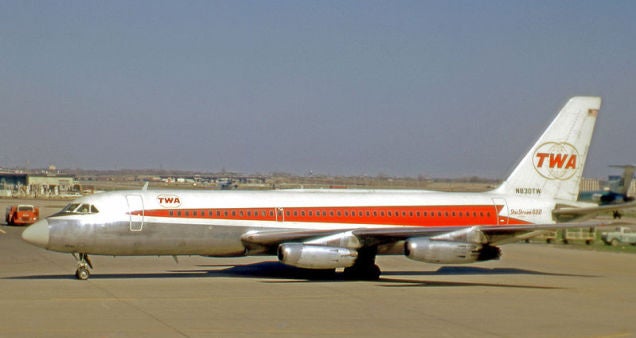 !!!CAPTION ERROR: MAY BE MULTI-LINE OR CONTAIN LINK!!!
!!!CAPTION ERROR: MAY BE MULTI-LINE OR CONTAIN LINK!!!
TWA achieved a few significant firsts, becoming the first airline to hire an African-American flight attendant, and the first to show in-flight movies. In 1969, TWA carried more transatlantic passengers than any other carrier, and it had grown to become the third largest airline in the world by 1972. However, by the 1980s, TWA had become more of a business interest for investors than a pilot-centered aviation service, though the airline did make perhaps its greatest achievement by carrying more than 50 percent of all transatlantic passengers in 1988.
 !!!CAPTION ERROR: MAY BE MULTI-LINE OR CONTAIN LINK!!!
!!!CAPTION ERROR: MAY BE MULTI-LINE OR CONTAIN LINK!!!
By 1995, though, TWA had entered bankruptcy and, despite an attempt to reinvent itself as a smaller domestic airline, TWA was purchased by American Airlines in 2001. TWA’s final, ceremonial final Flight 220 from Kansas City to St. Louis was flown by TWA CEO William Compton at the controls of a McDonnell Douglas MD-83 (N948TW). The story of one of the world’s greatest global airlines had come to an end with a flight of just 240 miles.
!!! UNKNOWN CONTENT TYPE !!!

(US Navy)
December 2, 1948 – The first flight of the Beechcraft T-34 Mentor. For many years, the !!!error: Indecipherable SUB-paragraph formatting!!! was the primary trainer for US military pilots, as well as many other air forces around the world. Over 15,000 Texans were built following its first flight in 1935, and its rugged design and and adaptability to many different missions made it a tough act to follow. Nevertheless, !!!error: Indecipherable SUB-paragraph formatting!!! , who had founded the !!!error: Indecipherable SUB-paragraph formatting!!! in 1932, rolled the dice following WWII and began development of what was dubbed the Beechcraft Model 45 to serve as a replacement for the venerable Texan, even though the US military had expressed no interest in a new trainer, nor did they have the budget for one.
 !!!CAPTION ERROR: MAY BE MULTI-LINE OR CONTAIN LINK!!!
!!!CAPTION ERROR: MAY BE MULTI-LINE OR CONTAIN LINK!!!
Based largely on the !!!error: Indecipherable SUB-paragraph formatting!!! , the Model 45 went through three design concepts, one of which employed the Bonanza’s signature V-tail, though in the end, Beech adopted a traditional tailplane to appeal to conservative military brass. The Bonanza fuselage was narrowed, and a bubble canopy was installed to allow better visibility for the tandem cockpit. The aircraft was also significantly strengthened to hold up under the rigors of military training. Power for the Mentor came from a !!!error: Indecipherable SUB-paragraph formatting!!! flat six-cylinder engine that offered 225 hp, and production of two main variants began in 1953: the T-34A for the US Air Force, and the T-34B for the US Navy, which was optimized for carrier operations. Both versions entered service in 1953.
 !!!CAPTION ERROR: MAY BE MULTI-LINE OR CONTAIN LINK!!!
!!!CAPTION ERROR: MAY BE MULTI-LINE OR CONTAIN LINK!!!
But with the jet engine becoming the primary powerplant for military aircraft, Beechcraft began another internal project to develop the T-34 into a jet trainer. This resulted in the Model 73 Jet Mentor, which was powered by a single !!!error: Indecipherable SUB-paragraph formatting!!! turbojet. However, when the Navy passed on the Jet Mentor, and the Air Force chose the !!!error: Indecipherable SUB-paragraph formatting!!! as their jet trainer, the Jet Mentor was abandoned after construction of just a single prototype. The piston-powered T-34 remained in service, though initial production halted in 1959.

Beechcraft T-34C Turbo Mentor (US Navy)
But the idea of a jet-powered Mentor never quite died, and T-34 production was restarted in 1973 at the request of the US Navy for a turboprop powered variant. This aircraft, powered by a !!!error: Indecipherable SUB-paragraph formatting!!! turboprop engine, was designated the T-34C and remained in service until the 1990s. In all, more than 2,300 Mentors were built throughout the two production runs, and many remain in private hands where they frequently perform on the air show circuit.
!!! UNKNOWN CONTENT TYPE !!!

Brewster F2A-1 Buffalo of the US Navy in 1941 (US Navy)
December 2, 1937 – The flight of the Brewster F2A Buffalo. History remembers and lionizes the great fighters of the Second World War, aircraft such as the !!!error: Indecipherable SUB-paragraph formatting!!! or the !!!error: Indecipherable SUB-paragraph formatting!!! , powerful and nimble fighters that clawed enemy aircraft from the skies, helped the Allies win the war, and are still revered today for their performance and beauty. The Brewster Buffalo, however, does not hold such a place in the pantheon of great fighters, and, in the years since WWII, the Buffalo has come to be regarded as a failure, a symbol of obsolescent technology and poor design. However, that scorn, for what is arguably an ungainly fighter, is not entirely warranted.
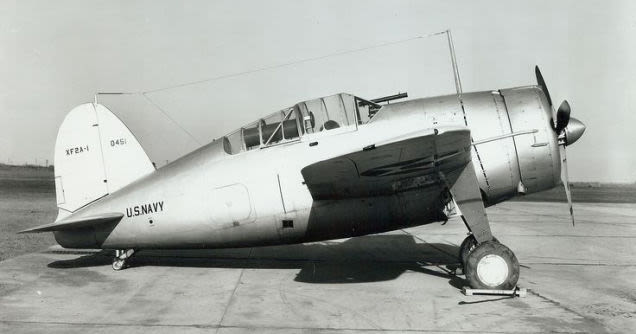
Brewster XF2A-1 prototype (US Navy)
The story of the Buffalo began in 1935, when the US Navy requested a new fighter to replace the !!!error: Indecipherable SUB-paragraph formatting!!! biplane. They accepted three entrants into the competition for a production contract: the Buffalo, the !!!error: Indecipherable SUB-paragraph formatting!!! , a biplane fighter with retractable landing gear which would eventually be developed into the !!!error: Indecipherable SUB-paragraph formatting!!! , and a navalized version of the !!!error: Indecipherable SUB-paragraph formatting!!! , which was quickly eliminated for its lack of speed. By the design standards of the 1930s, the Buffalo was a truly modern aircraft. It boasted all-metal, flush-riveted, stressed aluminum construction, !!!error: Indecipherable SUB-paragraph formatting!!! , and hydraulically operated retractable landing gear. It’s !!!error: Indecipherable SUB-paragraph formatting!!! radial engine provided a stout 950 hp, and the Buffalo had an impressive climb rate for its day, though its single-stage supercharger severely limited its high altitude performance. The Buffalo also lacked self-sealing fuel tanks or armor plating to protect the pilot, features that became standard on later American fighters. Armament was provided by a single .50 caliber machine gun and a single .30 caliber machine gun, both mounted in the nose.
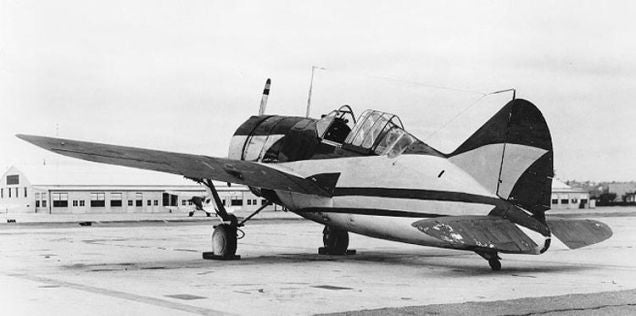 !!!CAPTION ERROR: MAY BE MULTI-LINE OR CONTAIN LINK!!!
!!!CAPTION ERROR: MAY BE MULTI-LINE OR CONTAIN LINK!!!
The first variant, the F2A-2, attempted to address some of the shortcomings of the F2A by providing increased armament and a more powerful engine, but the resulting weight gain nullified any performance improvements. The final version, the F2A-3, added improved range and provision for underwing stores, but the Navy and Marine Corps had already lost confidence in the Buffalo. By 1940 it was clear that the chubby fighter was completely outclassed by more nimble Japanese aircraft such as the !!!error: Indecipherable SUB-paragraph formatting!!! Zero and !!!error: Indecipherable SUB-paragraph formatting!!! (Oscar), and the remaining Buffalos were retired from combat following the !!!error: Indecipherable SUB-paragraph formatting!!! and transferred to Navy training squadrons in the US mainland. British experience with the Buffalo in Malaya and Burma was little better, with aircraft prone to oil leaks that fouled windscreens and speeds well under the manufacturer’s billing. Still, four Commonwealth pilots managed to become aces in the Buffalo early in the war.

Finnish Air Force B-239. The Finnish Air Force employed a blue swastika as its symbol from 1918-1945. Before being co-opted by the Nazi Party, the swastika was an ancient symbol of the sun and good fortune. (Finnish Government)
Despite the difficulties faced by Allied pilots, the Buffalo fared much better elsewhere, particularly in the hands of Finnish pilots, who liked the Buffalo and flew it with great effect. The export model was known as the B-239, and Finland’s greatest ace, !!!error: Indecipherable SUB-paragraph formatting!!! , scored 34 of his eventual 94.5 kills while flying a Buffalo against Russian fighters. Cooler weather, better maintenance practices, and superior tactics allowed greater success for the plucky fighter, and it served with distinction during the !!!error: Indecipherable SUB-paragraph formatting!!! . Just over 500 Buffalos were built, and they ended their service in 1948.
!!! UNKNOWN CONTENT TYPE !!!
Short Takeoff
!!! UNKNOWN CONTENT TYPE !!!
 !!!CAPTION ERROR: MAY BE MULTI-LINE OR CONTAIN LINK!!!
!!!CAPTION ERROR: MAY BE MULTI-LINE OR CONTAIN LINK!!!
November 30, 1986 – The first flight of the Fokker F100, a medium-sized twin-engine airliner and the largest jet airliner built by !!!error: Indecipherable SUB-paragraph formatting!!! before the company entered bankruptcy in 1997. Developed to replace the smaller !!!error: Indecipherable SUB-paragraph formatting!!! , the 100-seat F100 arrived at a time when there were few competitors for airliners of that size. Initial sales were strong, but competitors soon caught up and sales fell. In spite of the slump, it was ultimately financial mismanagement that doomed the storied aircraft builder, leading its parent company, !!!error: Indecipherable SUB-paragraph formatting!!! , to shut down the company in 1996. Fokker built 283 F100s before the company folded, and they remain in service with more than 30 operators and have logged more than 10 million flight hours.
!!! UNKNOWN CONTENT TYPE !!!
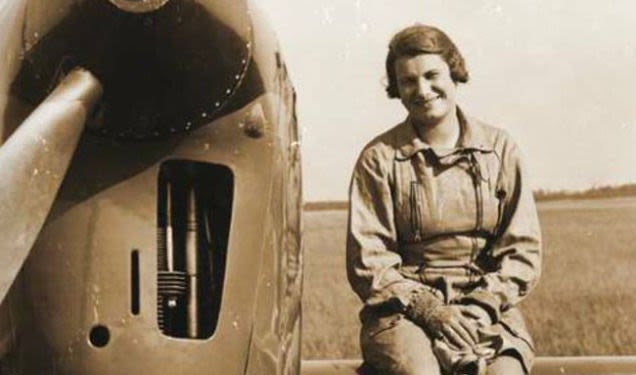
(Author unknown)
November 30, 1934 – The death of Hélène Boucher. Boucher was born on May 23, 1908, and purchased her first airplane, a !!!error: Indecipherable SUB-paragraph formatting!!! , in 1931 and learned navigation and aerobatics. She made a name for herself competing in air races and set several world records in 1933 and 1934, including one for altitude for a woman pilot and several speed records for flight over a distance of 1,000 km while flying a !!!error: Indecipherable SUB-paragraph formatting!!! race plane. Boucher died while flying a !!!error: Indecipherable SUB-paragraph formatting!!! when the aircraft crashed into a forest, and Boucher was posthumously made a knight of the !!!error: Indecipherable SUB-paragraph formatting!!! , France’s highest honor. She was also the first woman given the honor of lying in state at the !!!error: Indecipherable SUB-paragraph formatting!!! .
!!! UNKNOWN CONTENT TYPE !!!

(State Library of South Australia)
November 30, 1917 – The first flight of the Vickers Vimy, a twin-engine heavy bomber developed for the Royal Air Force late in WWI. By the end of the war, only three had been delivered to the RAF and they did not take part in the conflict. However, the size and long range of the Vimy made it an excellent candidate for long-distance record setters, and a Vimy flown by !!!error: Indecipherable SUB-paragraph formatting!!! and !!!error: Indecipherable SUB-paragraph formatting!!! has the distinction of being the first aircraft to complete a non-stop !!!error: Indecipherable SUB-paragraph formatting!!! in 1919. Others undertook notable long-distance flights from England to Australia and England to South Africa. With modifications to enlarge the fuselage, the Vimy was developed into the Vimy Commercial with accommodations for 10 passengers. The type was finally retired in 1933.
!!! UNKNOWN CONTENT TYPE !!!
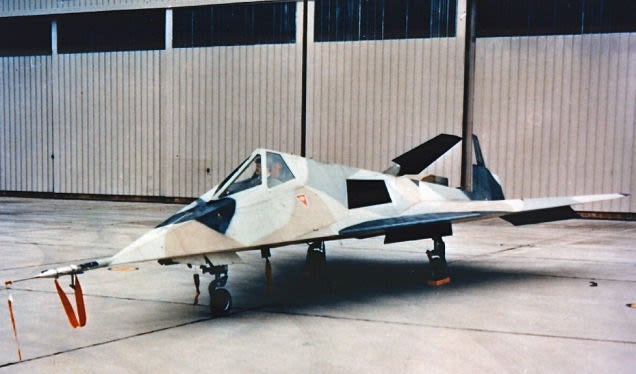
(US Air Force)
December 1, 1977 – The first flight of Have Blue , the code name for Lockheed’s proof of concept aircraft that demonstrated the capabilities of !!!error: Indecipherable SUB-paragraph formatting!!! aircraft design and developed manufacturing techniques and design elements that would be used on the production !!!error: Indecipherable SUB-paragraph formatting!!! . Unlike all previous aircraft that had been designed by aeronautical engineers, primary design of Have Blue was performed by electrical engineers who helped created the faceted shape that deflected radar signals and reduced the aircraft’s !!!error: Indecipherable SUB-paragraph formatting!!! . Two test aircraft were built, and both were lost to non-fatal crashes. Despite the mishaps, Have Blue was deemed a success, and led to the follow on program code named Senior Trend that resulted in the F-117.
!!! UNKNOWN CONTENT TYPE !!!

December 1, 1941 – The Civil Air Patrol (CAP) is activated. Originally envisioned in the 1930s as a civilian complement to America’s military flying branches, the CAP was officially activated by !!!error: Indecipherable SUB-paragraph formatting!!! when it was signed by New York Mayor !!!error: Indecipherable SUB-paragraph formatting!!! , Director of the Office of Civilian Defense. During WWII, CAP pilots flew surveillance missions to spot German U-boats off the American coast, and eventually located 173 enemy submarines and sank two. After the war, the CAP became the civilian auxiliary of the US Air Force, though it lost its offensive capabilities. Today, CAP pilots provide search and rescue services, disaster and humanitarian relief, and assist the US government with border patrols and drug interdiction. They are also instrumental in the education of new pilots, and help experienced pilots obtain Federal Aviation Administration ratings.
!!! UNKNOWN CONTENT TYPE !!!
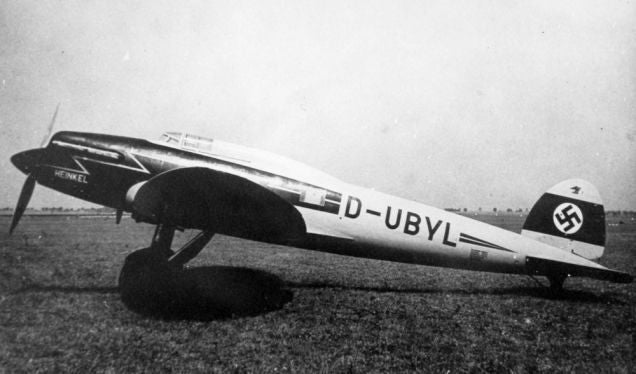
(San Diego Air and Space Museum)
December 1, 1932 – The first flight of the Heinkel He 70 Blitz (L ightning ), a high-speed mail and passenger aircraft designed by !!!error: Indecipherable SUB-paragraph formatting!!! of the !!!error: Indecipherable SUB-paragraph formatting!!! as a replacement for the slower !!!error: Indecipherable SUB-paragraph formatting!!! and !!!error: Indecipherable SUB-paragraph formatting!!! . Powered by a single !!!error: Indecipherable SUB-paragraph formatting!!! water-cooled V-12 engine, the Blitz captured a total of eight world speed records for its day, and !!!error: Indecipherable SUB-paragraph formatting!!! operated the He 70 as a mail and passenger plane from 1934-1937 with accommodations for four passengers. During the !!!error: Indecipherable SUB-paragraph formatting!!! , the He 70 was pressed into service as a fast reconnaissance bomber, but its lack of self-sealing fuel tanks and magnesium construction made it dangerously susceptible to fire. While the He 70 was not suited for duty in WWII, its elliptical wing and other design features found their way into the !!!error: Indecipherable SUB-paragraph formatting!!! twin-engine medium bomber.
!!! UNKNOWN CONTENT TYPE !!!

(NASA)
December 2, 1993 – The launch of Space Shuttle
Endeavour
on STS-61, the first mission to service the Hubble Space Telescope (HST).
The
!!!error: Indecipherable SUB-paragraph formatting!!!
was launched into Earth orbit in 1990, but faulty optics from an incorrectly ground mirror resulted in distorted images. In one of the most complex Shuttle missions ever, seven specially trained astronauts performed five extended extra-vehicular activity (EVA) periods to replace the
!!!error: Indecipherable SUB-paragraph formatting!!!
with the
!!!error: Indecipherable SUB-paragraph formatting!!!
corrective optics package, install the new
!!!error: Indecipherable SUB-paragraph formatting!!!
, replace four gyroscopes, and upgrade the computers. The HST was then boosted to a higher orbit. NASA considered the mission a complete success when Hubble began transmitting some of the sharpest
!!!error: Indecipherable SUB-paragraph formatting!!!
of the cosmos ever taken. Four additional servicing missions were flown, the last in 2009.
!!! UNKNOWN CONTENT TYPE !!!

(NASA)
December 2, 1976 – The first flight of the Shuttle Carrier Aircraft. Though NASA originally considered using the !!!error: Indecipherable SUB-paragraph formatting!!! to transport the Space Shuttle, they instead chose to modify a !!!error: Indecipherable SUB-paragraph formatting!!! airliner for the task, since the airliner employed a low wing and the C-5 would have to remain the property of the US Air Force. The first SCA (N905NA) was acquired from American Airlines in 1974, and a second (N911NA) was acquired from Japan Airlines in 1988 as a spare after the !!!error: Indecipherable SUB-paragraph formatting!!! . Modifications included the addition of mounting points for the Shuttle, a strengthened fuselage, improved avionics, more powerful engines, and the addition of vertical stabilizers at the end of the horizontal stabilizers for added control when the Shuttle was mounted. The SCA participated in glide tests of the original Shuttle !!!error: Indecipherable SUB-paragraph formatting!!! (OV-101), and ferried Shuttles from landings in California and New Mexico back to the launch site in Florida. Both SCAs were retired in 2012 at the end of the !!!error: Indecipherable SUB-paragraph formatting!!! .
!!! UNKNOWN CONTENT TYPE !!!

(Author unknown)
December 2, 1945 – The first flight of the Bristol Type 170 Freighter. The 170 was originally created as a measure to keep employees of the !!!error: Indecipherable SUB-paragraph formatting!!! working while the huge and ultimately unsuccessful !!!error: Indecipherable SUB-paragraph formatting!!! was under development. Placement of the cockpit above the cargo hold helped accommodate as large a payload as possible, and clamshell doors at the front facilitated cargo loading and unloading. An all-passenger variant was developed, called the Wayfarer, as well as a car-ferrying version that allowed passengers to bring their cars along on trips to the European Continent. Bristol built 214 Freighters between 1945-1958, and they served numerous civilian and military carriers around the world.
!!! UNKNOWN CONTENT TYPE !!!
 !!!CAPTION ERROR: MAY BE MULTI-LINE OR CONTAIN LINK!!!
!!!CAPTION ERROR: MAY BE MULTI-LINE OR CONTAIN LINK!!!
December 3, 2003 – The first flight of the Honda HA-420 HondaJet, the first aircraft developed by Honda Aircraft Company. The HondaJet was designed in Japan and manufactured in the United States at Honda’s factory in Greensboro, North Carolina. The maiden flight was performed by a proof-of-concept aircraft, not a final production model, and Honda announced in 2006 that it would commercialize the new light business jet. In March 2015, the HondaJet received its Provisional Type Certification from the FAA, and the aircraft is currently under production, with the first of approximately 100 orders delivered in 2018.
!!! UNKNOWN CONTENT TYPE !!!

(NASA)
December 3, 1973 – Pioneer 10 returns the first close-up images of Jupiter. !!!error: Indecipherable SUB-paragraph formatting!!! was launched on March 3, 1972 and reached Jupiter in November 1973. The probe eventually transmitted 500 images as it passed as close as 82,000 miles to our Solar System’s largest planet. The pictures returned by Pioneer 10 were of a higher quality than any image ever taken from Earth, and were displayed back on Earth in real time in a presentation that received an Emmy Award. The photographs allowed scientists to determine that Jupiter is composed mostly of liquid, and scientists could also discern weather patterns on the planet based on observations of Jupiter’s clouds. After passing Jupiter, Pioneer 10 became the first spacecraft to achieve !!!error: Indecipherable SUB-paragraph formatting!!! from the Solar System and, if left undisturbed, it will continue towards the star !!!error: Indecipherable SUB-paragraph formatting!!! , more than 68 light years away, though it will require more than two million years to reach the star at its current speed.
!!! UNKNOWN CONTENT TYPE !!!

(US Navy)
December 3, 1944 – The rescue of survivors from the destroyer USS Cooper . While on a mission to intercept Japanese supply ships near the Philippine Islands, !!!error: Indecipherable SUB-paragraph formatting!!! (DD 695) was torpedoed by a Japanese destroyer and sunk with the loss of 191 crewmen. 168 were rescued, including 56 who were loaded into a single US Navy !!!error: Indecipherable SUB-paragraph formatting!!! belonging to Patrol Bombing Squadronn VPB-34 and commanded by Lt. Joe Frederick Ball. A second PBY recovered 48 survivors . For his actions in rescuing a record number of victims, Ball received the !!!error: Indecipherable SUB-paragraph formatting!!! . The !!!error: Indecipherable SUB-paragraph formatting!!! reads in part:
[Ball] carried out the entire rescue with consummate skill and with total and repeated disregard for his personal safety, remaining on the water for almost an hour with many enemy planes in the vicinity, and repeatedly taxiing his plane well within point-blank range of guns on the enemy-held coastline and of two enemy warships, in his effort to pick up survivors. When his plane could hold no more, he was forced to make a run of three miles in order to get off the water.
!!! UNKNOWN CONTENT TYPE !!!
Connecting Flights
!!! UNKNOWN CONTENT TYPE !!!
!!! UNKNOWN CONTENT TYPE !!!
!!! UNKNOWN CONTENT TYPE !!!
!!! UNKNOWN CONTENT TYPE !!!
!!! UNKNOWN CONTENT TYPE !!!
If you enjoy these Aviation History posts, please let me know in the comments. And if you missed any of the past articles, you can find them all at
!!!error: Indecipherable SUB-paragraph formatting!!!
. You can also find more stories about aviation, aviators and airplane oddities at
!!!error: Indecipherable SUB-paragraph formatting!!!
.
!!! UNKNOWN CONTENT TYPE !!!
 farscythe - makin da cawfee!
> ttyymmnn
farscythe - makin da cawfee!
> ttyymmnn
12/03/2019 at 13:08 |
|
Honda HA-420 HondaJet
honda gets you higher?
 gmporschenut also a fan of hondas
> ttyymmnn
gmporschenut also a fan of hondas
> ttyymmnn
12/03/2019 at 13:21 |
|
Re Buffalo. How do ok we make an Uncompetitive model relative? Find an even more outdated adversary .
 user314
> ttyymmnn
user314
> ttyymmnn
12/03/2019 at 14:18 |
|
those first two passengers spent the eight-hour flight sitting on sacks of US Mail.
Probably still more comfortable than coach class on most US carriers nowadays.

It’s kind of surprising how small the Have Blue was, compared to the F-117 , though if you look at the size of the pilot’s chair compared to the canopy it’s rather obvious.
I’d also be interested to see if the Senior Prom program really was canceled in ‘82 as indicated, or if UAV versions really were flown over Eastern Europe prior to the collapse of the USSR, over Iraq during Desert Shield/Storm, or North Korea...




 ttyymmnn
> user314
ttyymmnn
> user314
12/03/2019 at 14:40 |
|
I’m flying coach tomorrow. I’ll let you know.
Hadn’t really noticed the size difference between Have Blue and Nighthawk. Interesting. Thanks for pointing that out. I always learn something when you comment. I appreciate that.
Look for a post tomorrow about the last Curtiss aircraft. Writing it gave me an idea to write about the two Glenns: Curtiss and Martin. Might be interesting.
 user314
> ttyymmnn
user314
> ttyymmnn
12/03/2019 at 15:45 |
|
I’d love to eventually get models of the Tacit Blue, Have Blue and Boeing Bird of Prey together, maybe include the YF-23 and X-32.
 ttyymmnn
> user314
ttyymmnn
> user314
12/03/2019 at 16:28 |
|
I’d like to get a Revel kit of the YF-17. I bet it exists.
 user314
> ttyymmnn
user314
> ttyymmnn
12/03/2019 at 16:45 |
|
Not from Revel l, no. Anigrand has a 1/72 scale resin kit though:
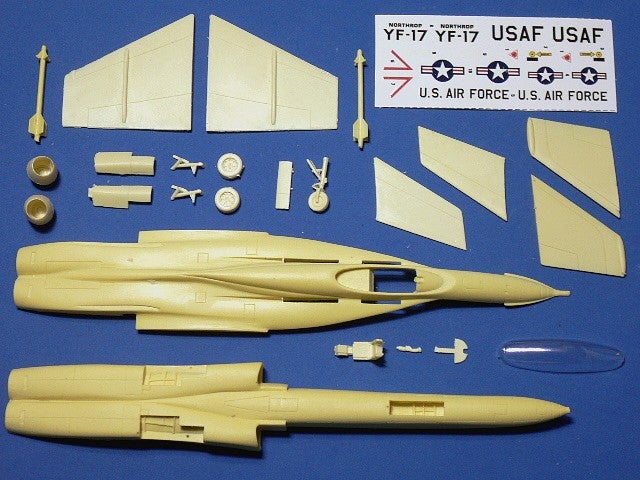
Now, Revell did release a kit of the Y F-16 (more or less), which you can grab off eBay :

 ttyymmnn
> user314
ttyymmnn
> user314
12/03/2019 at 17:17 |
|
My brother built that GD F-16 back in the day. I’ve got a half-built F/A-18A in my garage that I’ve had for probably 30 years.
 ttyymmnn
> user314
ttyymmnn
> user314
12/03/2019 at 17:17 |
|
Also, $58! Yikes! I guess it’s a collector’s item now.
 Jayvincent
> ttyymmnn
Jayvincent
> ttyymmnn
12/04/2019 at 06:50 |
|
If you haven’t read it already, I’d recommend
!!! UNKNOWN CONTENT TYPE !!!
. Liner notes from Amazon:
Captain Robert N. Buck retired from TWA after having flown well over two thousand Atlantic crossings and thirty-seven years of service as chief pilot and director of thunderstorm research. During World War II he was engaged in weather research for the U.S. Air Corps, for which he was awarded, as a civilian, the Air Medal by President Harry Truman. More recently, Buck has worked with the International Civil Aviation Organization — the UN’s body for aviation — to develop a new plan of world airspace.
In North Star over My Shoulder, Bob Buck tells of a life spent up and over the clouds, and of the wonderful places and marvelous people who have been a part of that life. He captures the feel, taste, and smell of flying’s great early era — how the people lived, what they did and felt, and what it was really like to be a part of the world as it grew smaller and smaller. A terrific storyteller and a fascinating man, Bob Buck has turned his well-lived life into a delightful memoir for anyone who remembers when there really was something special in the air.
 ttyymmnn
> Jayvincent
ttyymmnn
> Jayvincent
12/04/2019 at 07:29 |
|
Looks like a good read. I wonder if he took part in Project Thunderstorm.
https://www.historynet.com/project-thunderstorm.htm
 gmporschenut also a fan of hondas
> user314
gmporschenut also a fan of hondas
> user314
12/04/2019 at 08:06 |
|
I knew an engineer, his first job out of college in teh 70s was analysing and filtering EM signals and comparing them to another set of data. Turns out for 2+ years his group was backwards engineering soviet radar sights, that the airforce built in middle of nowhere nebraska, that were later used to test the stealth aircraft.